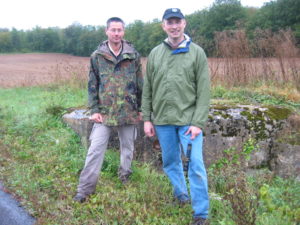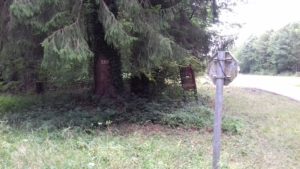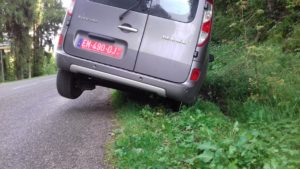The last Travel Tips topic–“Seeking Permissions…”–received so much feedback that the Webmaster felt it best to follow this up immediately with a discussion of “Practical Safety (and Comfort) Tips for Your Pilgrimage.” Many of the cultural topics have been covered in the “La Vie en France” blog post category or elsewhere on this website; but repetition can be a good thing given the large numbers of Americans planning to travel “Over There” this fall. The goal is not to scare anybody from making a pilgrimage to the battlefields. The objective is to give readers the tools to have a safe and rewarding pilgrimage! Bon voyage!!
Introduction
- What Works in France
- What Does not Work in France
- How to Have a Wonderful Trip in France–or Anywhere Else Overseas
- Readers are encouraged to sort the 200+ blog posts in the “Blog” section of this website and to focus on the “Travel Tips” and “La Vie en France” categories.
In the Forest and in the Field
- Be respectful of private property and seek permission before entering. See “Travel Tips: Seeking Permission to Enter Property…”
- Remember that digging and the use of metal detectors to find things is strictly forbidden.
- Be VERY AWARE of your surroundings. Even along the path and in fields one still finds: unexploded ordnance; barbed wire and screw pickets sticking up out of the ground; underground tunnel entrances that could collapse, etc.
- DO NOT PICK UP, MOVE OR TAKE ANY UNEXPLODED BOMBS, GRENADES, AMMUNITION, ETC. They are potentially live. Take a picture of it for the memory, and mark it, if possible.
- Do not enter any underground installations: You do not have the experience, equipment and lighting for safety.
- Cell phone coverage in the woods is spotty at best.
- Because of #3 and #6, exploring the woods alone is NOT a wise decision: A simple sprained ankle becomes a problem if you are two kilometers away from your car.
- If you must go alone, communicate to someone where you intend to go and when you intend to return. They can contact authorities, if there is a problem.
- Hunts are popular in the Fall and they occur typically on a Saturday or Sunday. The area of the hunt is generally well-posted, complete with sentinels along the roads. Nevertheless, if you are in the field and you hear the horns and dogs (for wild boar), it is best to leave the area quickly and come back another time.
- If there are sights and sounds of active logging, it is best to stay clear of the area.
- Ticks and Lyme Disease are a problem in France too. Wear long clothes and do a tick check.
- Stay hydrated and avoid low blood sugar by carrying water and snacks.
A Few Words on Clothing
- Dress practically for the field. You can change into something nicer for dinner.
- Footwear should be sturdy and somewhat waterproof: Hiking boots or good trekking shoes are suggested.
- Pants should also be sturdy. Long pants are preferred because of brush and ticks.
- The Webmaster generally brings a long-sleeve shirt, wool sweater and outer coat. These can be combined as needed for the weather of the moment, with the unnecessary items remaining in the car.
- A fold-up umbrella is also helpful for those days when it really rains.
- It is always a good idea to have a flashlight handy to view into pillboxes, etc.
Navigating in the Woods
- Woods are parceled into sections that are separated by paths. On the map, these paths are generally represented by a long dash —.
- Each parcel is numbered; identifying that specific parcel. Hikers will find these numbers at each junction of paths.
- Therefore, by keeping track of the parcel numbers passed, one knows how far one has ventured into the woods.
- The parcel numbers were printed on old IGN maps.
- Unfortunately, they have been omitted from current IGN maps and the ABMC maps of the time.
- It is always best to have a compass and a map (in a water-proof container) in the field: One cannot always rely on being able to receive a GPS signal in the woods.
More Safety and Comfort Tips
- Don’t leave valuables visible in your car: It stands out like a sore thumb. (French license plates reflect the Departement in which one lives: Ardennes = 8, Marne = 51 and Meuse = 55. Your rental car is most likely registered in another Departement.)
- Rural France is very different from suburban or urban United States–some of the differences are cultural reasons and some reflect the sparse population.
- There are few “comfort facilities” in the woods or villages, so be prepared. See “La Vie en France #10–Finding Suitable Places for Ladies to Pee.”
- Keep a full tank of gas, because gas stations are few and far between, and hours are limited. See “La Vie en France #9–Cheap Gas, Sundays and Creative Solutions.”
- Because of the rural nature, it is always best to load a supply of food and water in the car before setting off. (There are little supermarkets in Varennes, Doulcon and Grandpre and Hypermarkets in Verdun and Stenay)
- Most shops and businesses–other than restaurants and cafes–are closed between 12h00 and 14h00. So don’t plan on shopping or taking care of business at lunch time. (An exception seems to be hypermarkets such as Cora and Intermarche that have a restaurant on site.)
- Pay 100% attention to driving in France: Rural roads are much narrower and often windier than American roads. A little distraction and you are off the road.
- Because of the sparse population, it can take some time for a tow truck or ambulance to arrive.
- Beware of local drivers who know the roads well and who drive amazingly fast.
- Rural France has very few facilities for people with limited mobility. (Note: The Arara B&B in Montfaucon has two rooms that are specially adapted.)
- Country hotels and B&Bs generally have no air conditioning in France.
- If you are not feeling well, a trip to a local Pharmacie can often yield a prescription or homeopathic remedy–without the need to visit a doctor. In Europe, pharmacists can write prescriptions.
Putting Things into Perspective
Rural France is not nearly as scary as the lists above suggest. It is very beautiful; and visiting the battlefields is very moving. It’s people are also wonderful in some ways and frustrating in others–much like Americans. When the Webmaster drove his car off the road and got stuck in a soft shoulder, more than half of the drivers passing by stopped and asked (in French) if they could help. One driver, who spoke good English, called the rental company for a very nervous Webmaster. It took almost an hour for the tow truck from Doulcon to arrive at the small village of Vaux (near Fort Vaux); but that is only because of the distance. Americans have been making pilgrimages to the battlefields of France ever since before the war ended; and the great bulk of them have had wonderful experiences. A little common sense and preparation go a long way toward ensuring an excellent pilgrimage!




